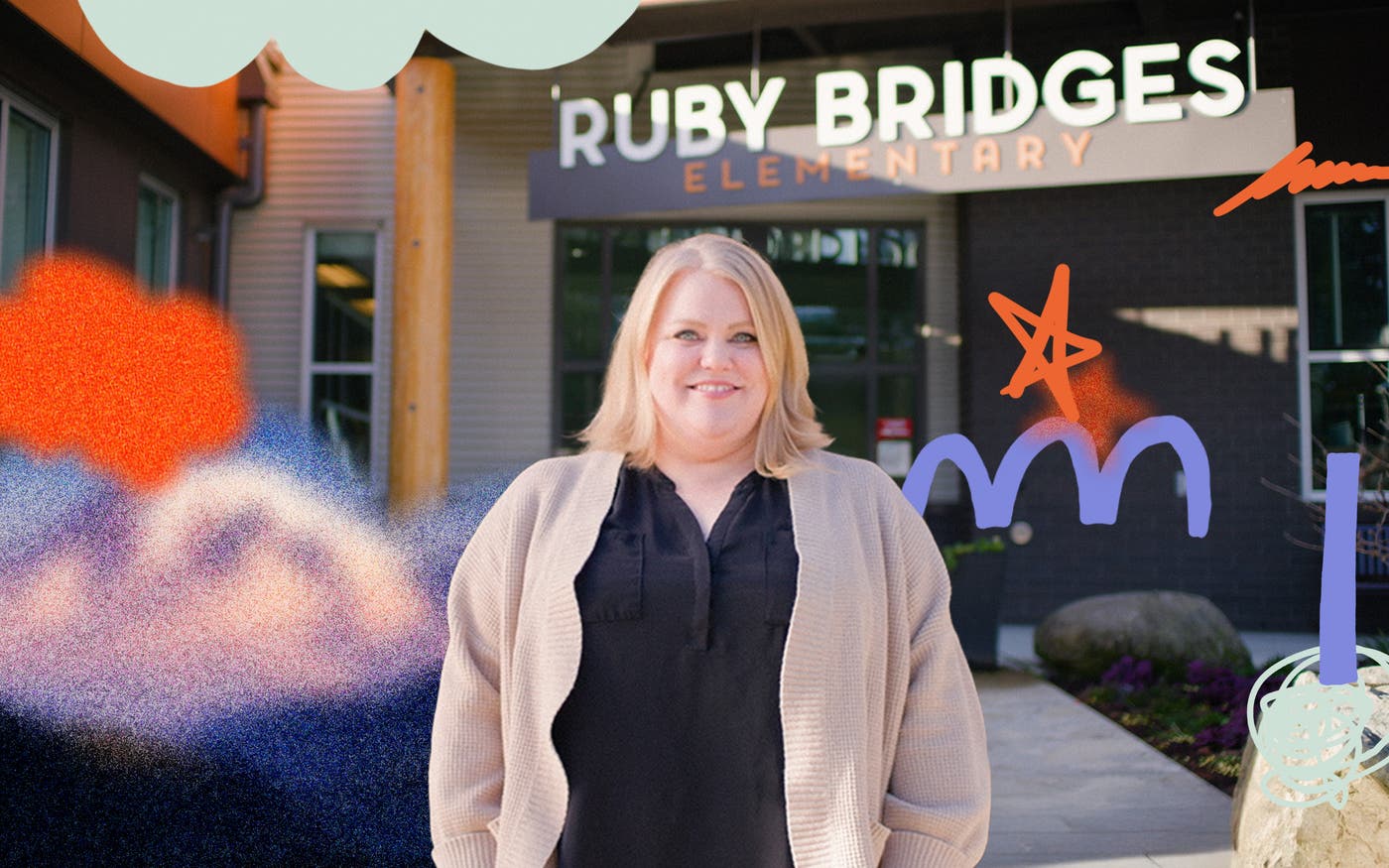
Come as you are
Wiggling is welcome in this kindergarten classroom
Kim Broomer’s classroom is one of the most unique and supportive learning environments I have ever heard of.

When I was a kid, I couldn’t sit still. My teachers used to get mad at me for squirming in my chair and chewing on my glasses and pencils. At the time, I felt like I was doing something wrong. Now I know that those movements helped me process my environment and stay engaged in class.
I probably would have felt a lot better about my restlessness if I had been in Kim Broomer’s class. Kim is this year’s Washington State Teacher of the Year, and her classroom is one of the most unique and supportive learning environments I have ever heard of.
Kim teaches kindergarten at Ruby Bridges Elementary School in Woodinville, a suburb of Seattle located about 45 minutes from downtown. It’s a full-inclusion school, which means that students with a wide range of learning and communication needs learn alongside one another in the same class throughout the day.
Some of Kim’s students are non-speaking. Others are autistic, experience dyslexia, or have been identified as highly capable or multilingual learners. “At our school, we include all children,” she explains. “We don’t segregate students based on any one aspect of their identity.” Fittingly, the school is named after the civil rights icon who was the first Black student to integrate an all-white school in Louisiana.
Ruby Bridges Elementary opened five years ago in the middle of the pandemic. Kim helped launch the school, working with other staff and under the leadership of her principal, Cathi Davis—who was recently named the Washington State Elementary Principal of the Year. Together, the staff has built something truly exceptional.
Eighteen percent of the student body receive special education services, which is only a little higher than the national average of 15 percent. In other words, Kim’s classroom looks pretty much like any other in the U.S. at first glance. The differences only become obvious over the course of the day.
In most schools, students who need help from specialists leave their classroom to work with them. At Ruby Bridges, that’s not the case. Occupational therapists, language pathologists, and other professionals instead come into Kim’s classroom to work directly with kids. This means that kids get to remain in class, and all students get to benefit from the additional knowledge and support.
That makes a huge difference. When students are pulled out of class, they receive an average of 35 percent fewer instructional minutes. And being removed can send the wrong message—both to the student and to their peers—about who belongs and who doesn’t.
In contrast, Kim’s students learn that there’s nothing wrong with needing help—after all, everyone relies on some kind of support to live, learn, and work. Maybe you’re like me and you need glasses to see. Maybe you need to start your day with a cup of coffee, or you prefer to get work done while listening to music with headphones on. Maybe you’re like some of Kim’s students, and you use an app to help you communicate. “We all have strengths, and we all have things that we’re working on,” she says. “We all can succeed under the right atmosphere with the right supports.”
I was fascinated by Kim’s approach to sensory regulation in the classroom. Many of her students engage in stimming—self-regulating or repetitive movements that help them stay grounded and focused, like the kind I used to do as a kid (and still do today sometimes). These behaviors are often misunderstood or discouraged in traditional classrooms, but Kim sees them as valid and essential.
Special tools let Kim’s students regulate their sensory needs without disrupting the classroom. Some of her students like to wiggle or shake things, so she provides them with quiet toys that make no noise. She showed me special pen caps that are meant to be chewed on. She even has special wobble chairs that let students move their bodies while staying safe and engaged. Because these types of tools are available to everyone and so common in her class, her students don’t think twice about them. They’re simply seen as part of how people learn.
The benefits for students who have disabilities are obvious, but what about everyone else? Kim told me that some families worry that their kids might get less attention—but she makes a compelling case for why a full-inclusion classroom helps everyone. “All children benefit from learning in diverse communities,” Kim says. “In Kindergarten, where I teach, every student is still developing language, communication, and emotional regulation. It’s the perfect place to lay the foundation for inclusive learning.”
The data backs her up: Students at Ruby Bridges outperform district and state averages in reading and math. And, beyond academics, they’re learning empathy that will guide them through the rest of their lives. “Your child is going to be a kinder, more empathetic human being because they’ll have relationships with people who speak differently, move differently, and express themselves in different ways,” says Kim.
Unfortunately, as an elementary school, Ruby Bridges only serves kids through 5th grade. When students move on to middle school, they often find themselves separated from the inclusive community where they thrived. It’s heartbreaking for the families, and I wish they had the choice to continue. “One day, these kiddos will grow up,” Kim told me. “The relationships they build now in inclusive classrooms are the foundation for the communities they’ll lead tomorrow.”
I hope more schools follow Ruby Bridges’ example. It’s fantastic to see how Kim brings every child in and helps kids connect with one another. Her students aren’t just learning math and reading—they’re learning how to be the kind of people who build a better world.


